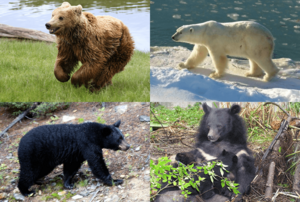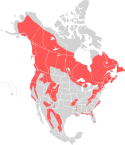Ursus (mammal) facts for kids
Quick facts for kids Ursus (mammal) |
|
|---|---|
 |
|
| From top to bottom: brown bear, American black bear, polar bear, Asian black bear | |
| Scientific classification |
|
| Kingdom: | Animalia |
| Phylum: | Chordata |
| Class: | Mammalia |
| Order: | Carnivora |
| Family: | Ursidae |
| Subfamily: | Ursinae |
| Tribe: | Ursini |
| Genus: | Ursus Linnaeus, 1758 |
| Type species | |
| Ursus arctos Linnaeus, 1758
|
|
| Species | |
|
|
| Synonyms | |
|
|
Ursus is a genus in the family Ursidae (bears) that includes the widely distributed brown bear, the polar bear, the American black bear, and the Asian black bear. The name is derived from the Latin ursus, meaning bear.
Taxonomy and systematics
Extant species
| Common name and scientific name | Image | Subspecies | Distribution |
|---|---|---|---|
| American black bear Ursus americanus Pallas, 1780 |
 |
16 subspecies:
U. a. altifrontalis – Olympic black bear U. a. amblyceps – New Mexico black bear U. a. americanus – Eastern black bear U. a. californiensis – California black bear U. a. carlottae – Haida Gwaii black bear or Queen Charlotte Islands black bear U. a. cinnamomum – cinnamon bear U. a. emmonsii – glacier bear U. a. eremicus – East Mexican black bear U. a. floridanus – Florida black bear U. a. hamiltoni – Newfoundland black bear U. a. kermodei – Kermode bear or spirit bear U. a. luteolus – Louisiana black bear U. a. machetes – West Mexican black bear U. a. perniger – Kenai black bear U. a. pugnax – Dall Island black bear U. a. vancouveri – Vancouver Island black bear |
 |
| Brown bear Ursus arctos Linnaeus, 1758 |
 |
15 subspecies:
U. a. arctos – Eurasian brown bear U. a. collaris – East Siberian brown bear U. a. beringianus – Kamchatkan brown bear †U. a. californicus - California grizzly bear (extinct) †U. a. crowtheri – Atlas bear (extinct) †U. a. dalli – Dall Island brown bear (extinct) U. a. gyas - Alaska Peninsula brown bear U. a. horribilis – grizzly bear U. a. isabellinus – Himalayan brown bear U. a. lasiotus – Ussuri brown bear U. a. middendorffi – Kodiak bear †U. a. nelsoni – Mexican grizzly bear (extinct) U. a. pruinosus – Tibetan blue bear U. a. sitkensis – Sitka brown bear U. a. stikeenensis - Stikine brown bear U. a. syriacus – Syrian brown bear |
 |
| Polar bear Ursus maritimus Phipps, 1774 |
 |
|
 |
| Asian black bear Ursus thibetanus (G. Cuvier, 1823) |
 |
7 subspecies:
U. t. formosanus - Formosan black bear,
U. t. gedrosianus – Balochistan black bear or Pakistan black bear U. t. japonicus – Japanese black bear U. t. laniger – Himalayan black bear U. t. mupinensis – Indochinese black bear U. t. thibetanus – Tibetan black bear U. t. ussuricus – Ussuri black bear |
 |
A hybrid between grizzly bears and polar bears has also been recorded. Known commonly as a pizzly, prizzly, or grolar bear, the official name is simply "grizzly–polar bear hybrid".
Fossils
- †Ursus deningeri Richenau, 1904
- †Ursus dolinensis (Garcia & Arsuaga, 2001)
- †Ursus etruscus Cuvier, 1823
- †Ursus ingressus Rabeder, Hofreiter, Nagel & Withalm 2004
- †Ursus kudarensis Baryshnikov, 1985
- †Ursus minimus (Devèze & Bouillet, 1827)
- †Ursus pyrenaicus (Depéret, 1892)
- †Ursus rossicus Borissiak, 1930
- †Ursus savini (Andrews, 1922)
- †Ursus sackdillingensis Heller, 1955
- †Ursus spelaeus Rosenmüller, 1794
- †Ursus vitabilis? Gidley, 1913
Mating system ecology
Both males and females mate with more than one partner and use various strategies to increase their reproductive success. Unlike more social species bears, being solitary mammals, have wide-ranging habitats to locate potential mates. ue to the asynchrony of oestrous phases and lengthy parental care by females, bear populations are usually male-biased, meaning that females are more choosy and males are more competitive. Male-male competitions are common, influenced by female mate choice.
Mating seasons fluctuate based on species dependent on geographical location. American black bears (Ursus amercanus), brown bears (Ursus arctos) and polar bears (Ursus maritimus) all have mating seasons occurring within a three-month duration during the spring and summer months (approximately May – July), with delayed implantation occurring in late fall (November), and cubs born within the den during early winter (January). Females, on average, mate with three to four males during a mating season and mating males have more variation, mating with one to eight females during a mating season. Since reproductive success is positively correlated with age and size in bear populations, there are also males that do not mate at all until they are able to compete with larger males. There is a very loose dominance hierarchy within bear mating systems due to their solitary nature. Majority of dominance hierarchies are found at food congregations in which population density is high and individuals are ranked based on size, mass, aggressiveness and willingness to fight. Overall, dominance hierarchies have lower adaptive strategies in solitary species and dominance is established based on encounters during the breeding season.
The mating system is generally characterised by two main components, the search phase and the encounter phase. During the breeding season, both males and females expand their home ranges to help increase the likelihood of finding potential mates. Males, especially, adapt a roaming strategy, covering a large geographic range to find receptive females and tracking them via chemoreceptors. Male bears are not considered to be territorial, but they do have large home ranges that may overlap with female home ranges, giving them access to a range of 3–15 females.
See also
 In Spanish: Ursus para niños
In Spanish: Ursus para niños

